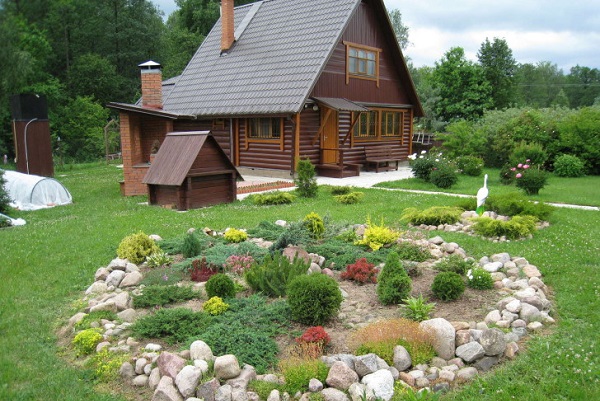
A flower bed made of stones is a spectacular design solution that gives the garden brightness and originality. To build a flower bed from such a simple but promising natural material, and thereby create a unique landscape masterpiece, you can do it yourself without resorting to the services of professionals.
Content
Popular types of flower beds from stones
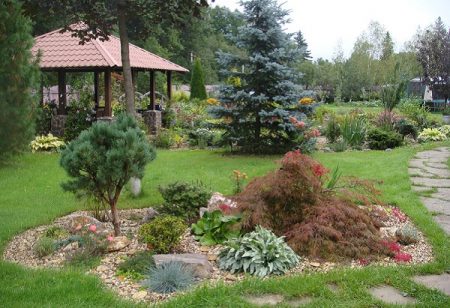
Stone is an ideal element for decorating the garden. Its presence among plants brings to the front garden style, primitive beauty and originality. There are many options for flower beds using hard rocks, different in shape, color and structure. To create a flower bed you need only imagination and suitable materials. Some prefer classics or minimalism, others cannot do without intricate geometric shapes, still others add water to the flower garden’s decor, others arrange flower beds on a raised platform, decorating the front garden with stony fences. In small areas, you can use stones to make a flower tower, and in large gardens, arabesques and rock gardens with a pond look great.
Based on preferences, as well as features of the geography of the summer cottage, you can choose the most suitable option and make your front garden unlike the rest.
A stone flower bed is an ideal element of the zoning of a garden plot.
Arabesque
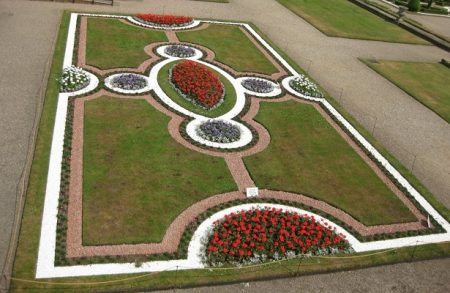
As a form of flower planting, it is not used very often, although it is a very beautiful decoration solution for a large garden. The arabesque is a plant web that is located horizontally on the surface (or slightly raised). The composition always has a certain pattern. It can be a butterfly, wings, leaves, flowers, etc. These types of flower beds perfectly adorn the sides of the stalls and flower beds.
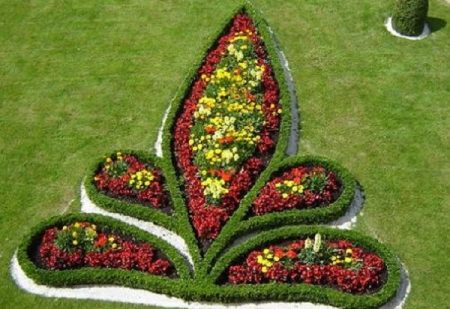
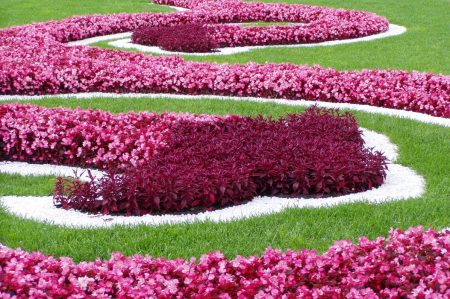
As a rule, an arabesque is planted with creeping plants, but it happens that small pebbles are added to the composition to give the flowerbed a more voluminous and clear appearance. She falls asleep in the voids between the flowers. When creating such a flower bed, plants are selected whose height is not more than 15 centimeters. Flowers should be bright contrasting tones, planted in the same color, and not differently. It is ideal to place arabesques on small slopes so that the flowerbed pattern is better visible. The reason for the infrequent use of arabesques in modern design is the laborious care of plants in comparison with perennials and other plantings and require significant costs.
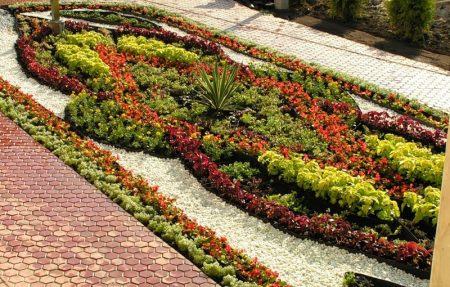
Rock garden
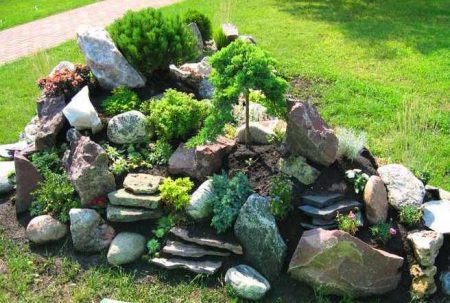
An artificial structure in the form of a hill or a garden on a hillside, conveying all the beauty of alpine nature. The rock garden, in other words, transfers the entourage of a wild mountainous local to the territory of a summer cottage. When creating it, plants of alpine terrain are used. A multi-level flower garden in which stones and flowers are harmoniously combined - annuals, perennials, shrubs. The size of the rock garden can be different, depending on the preference of the summer resident.
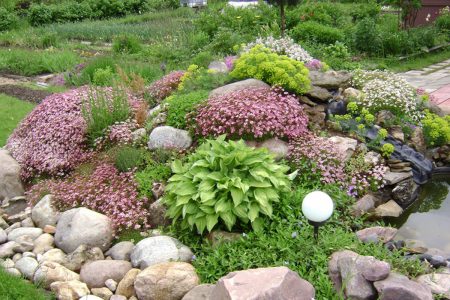
A rock garden is not a specific set of rules for laying stones, but the pure creativity of an architect. True, it consists in creating the most natural mountain landscape. He can make a corner to his liking, adding also streams or water cascades.
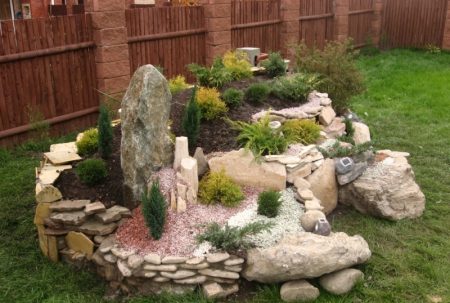
A rocky landscape is built by autumn, so that by spring the soil has settled to its limit and has taken its final shape.The basis of any rock garden is a drained layer, on top of which they fill the nutrient soil mixed with peat or small gravel. For fastidious plants knead "their" soil and spread, based on the location of whimsical plants.
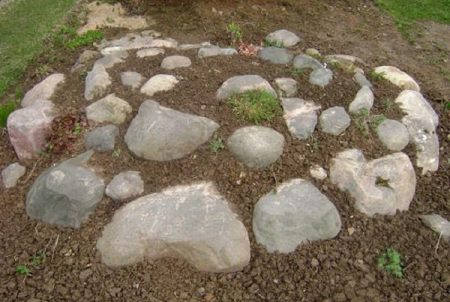
After that, a hill of land is covered with boulders of various sizes and shapes. One condition: they must all be of the same breed - it will be more beautiful. Plants are planted as expected in the spring. In decorative rock gardens, it is permissible to mix different flower varieties in order to achieve maximum decorative effect.
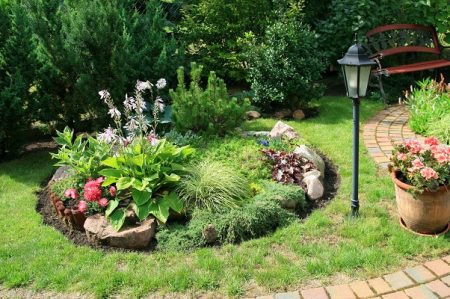
Rockery
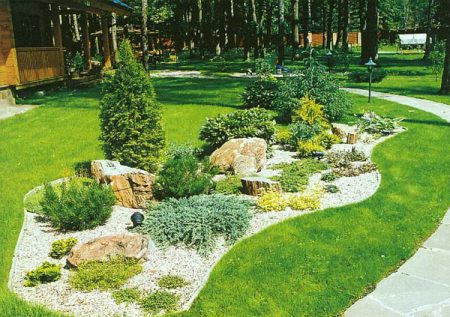
Rockery is a harmonious combination of voluminous cobblestones and dwarf, often evergreen, plants. Similar compositions evoke Asian motifs, they are like “yin and yang” - fragile flowers grow in close proximity to ancient stone materials. Rockeries need a large territory, over which huge boulders and small stones are intricately scattered. Most often it is slate and limestone. Large stones are dug into the ground, and small stones are scattered across the voids. Creeping plants, dwarf shrubs, mosses and lichens are planted between boulders, crevices and cracks.
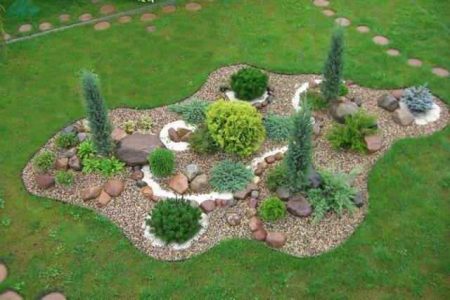
There are many options for performing rockeries. For a small garden, you can arrange a flower bed without adding large stones, or do with rocks of medium and small sizes. If the place allows, arrange multilevel rockeries with the addition of water. Most often this is a waterfall, the water of which flows down the central boulder directly into a small pond. Stones are scattered around the reservoir and dwarf flower species are located, which are well tolerated in close proximity to water.
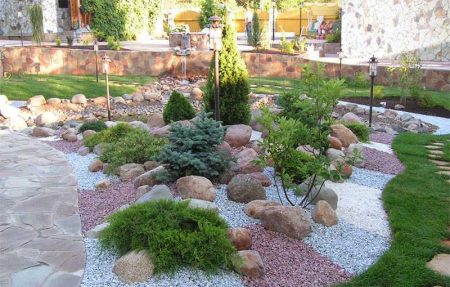
Rockeries look good on flat horizontal surfaces and in the form of stairs in a hilly area. The stone wall, which is all covered with loaches, looks very impressive.
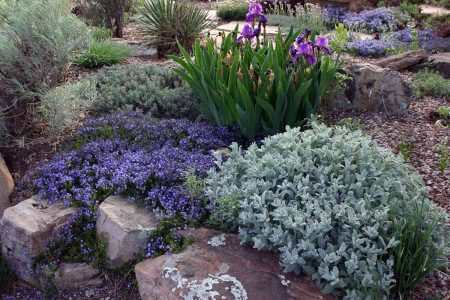
Rockeries and rock gardens have much in common in their device. All of them represent sites with a rocky base on which various plants are planted. The difference between these stone beds lies in the planting conditions. While the rock garden is a rocky hill, covered with flowers and herbs, rockeries equip on a horizontal surface. The rock garden is done in a sunny area, and the rock garden is in the shade. For alpine mountain landscapes, mountain plants from the alpine zone are used, and dwarf stands of absolutely any climate are planted in rockeries.
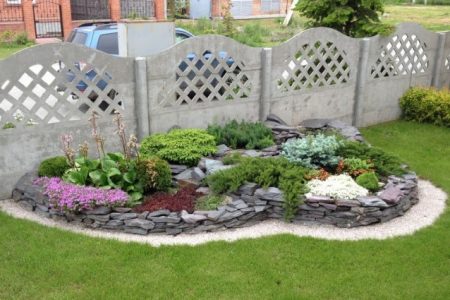
Japanese garden
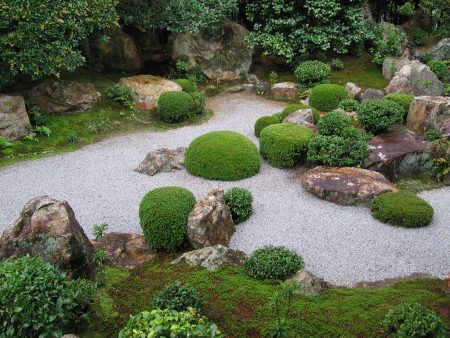
The most extravagant stone flower beds include Japanese gardens, different from other similar structures in that they consist mainly of stones. They have a minimum of plants and they all make up only mosses and lichens. Such gardens in Japanese culture symbolize the world, a limitless universe. This can be seen in the contours of the compositions - there are no angles and asymmetries. All borders are smooth, rounded, with no "end". Stones in Japanese mythology denote the nature from which a person must learn. A rock garden also means the immutability of the world. Just as stones lie in their place in such a “garden” for millennia, so does our world, its foundation.
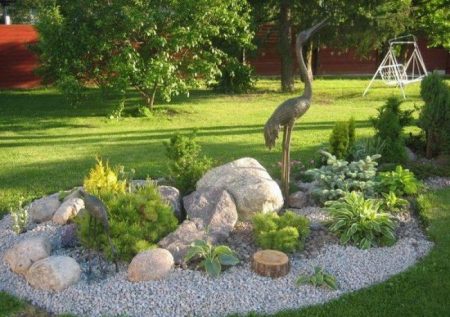
The Japanese call their gardens "Karesansui", that is - "dry garden".
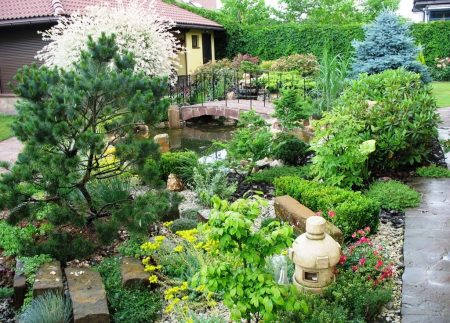
The Japanese Garden is a horizontal area, completely covered with plain (often white) small stones. In other countries, when arranging such gardens, multi-colored specimens are used. In this “sea” of stones there are green islands with the stone heart of a large boulder. For the arrangement of the garden, the Japanese use only natural uncultivated breeds in their original form. Using a rake, the stones are leveled, creating low grooves that lead to the islets. Looking down on the whole composition, you can see a distinct wave-like pattern.
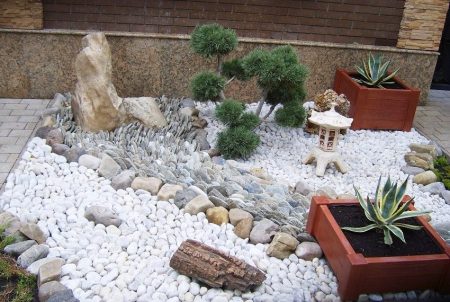
According to the rules of creating a Japanese garden, the amount of material used should always be odd, and the composition itself is never symmetrical.The picture of the “flowerbed” can be viewed from any angle and the eyes will always consist of the same number of stones. This also speaks of the stability and constancy of the world.
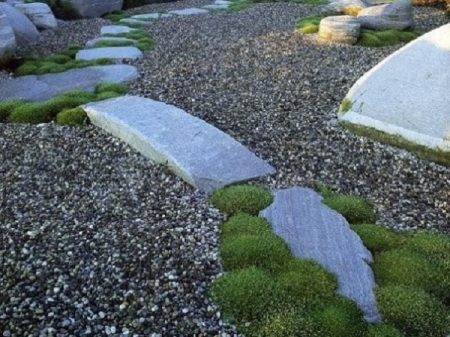
Stones are divided into five groups. One of them is the main one, the rest are secondary. Each group sets the tone for the composition. They are arranged in a triad: one large and two small nearby. Each stone, in turn, also has its own symbolism.
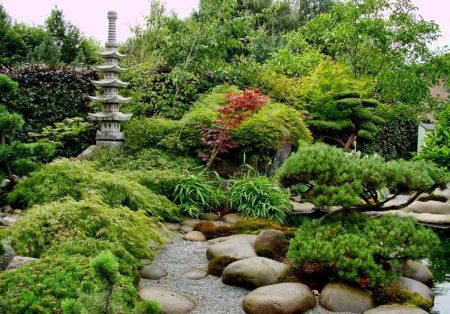
Rean-ji Temple Garden is the most famous stone garden in the world. It is based on 15 stones, but only an enlightened person can see them all.
Gabion
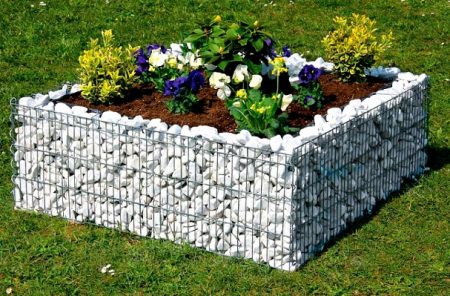
The building structure, which is a container of twisted metal wire, which is filled with stone (sandstone, gravel, slate, granite) was previously used in a completely different area of human life. They were used to strengthen structures during military operations. Gabions "propped up" the riverbanks, walls, strengthened slopes. Today, these mesh devices with clear shapes are used to decorate the garden.
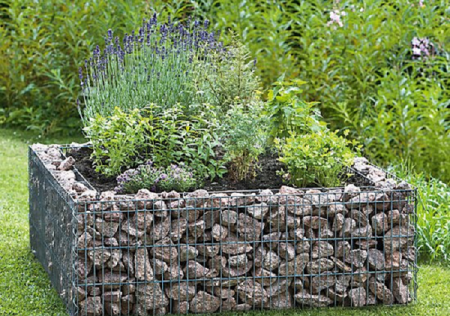
Gabions perform any volume, size, height. The mesh frame is installed in the required place, and is poured to the top with large gravel. A greater effect of such a composition can be achieved by laying a white stone. Gabions can be used as an element of the fence, arch, fencing. By order, they can be made of any shape - curved or strict rectangular. When arranging flower beds from this decor element, the upper part of the gabion is covered with fertile soil and unpretentious low-growing flowers or ampelous plants are planted that will hang down a stone wall. Gabion can also be used as a border, letting it go along the perimeter of the flower garden.
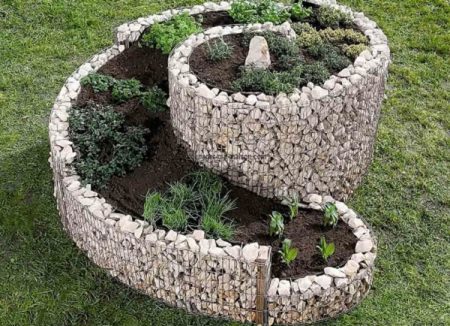
More common gabions of direct forms, since they cost several times cheaper than curved compositions.
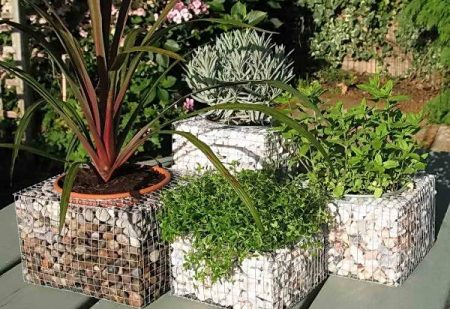
Standard flower bed
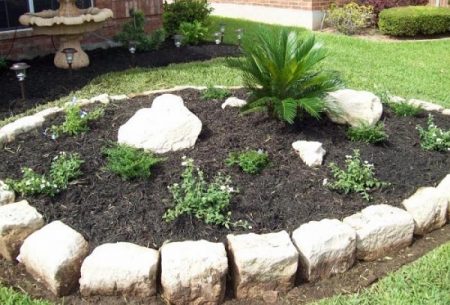
The most primitive use of stone in landscape design is its placement along the border of a flower bed. Stones in this case outline the border of the front garden, clearly defining its shape and size. You can use slate or limestone, laying thin plates in several layers, creating an impromptu border. Flowerbed with a stone fence are most often round or oval. They are arranged around a tall tree, planting dwarf flowering plants to it. Typically, these beds are small.
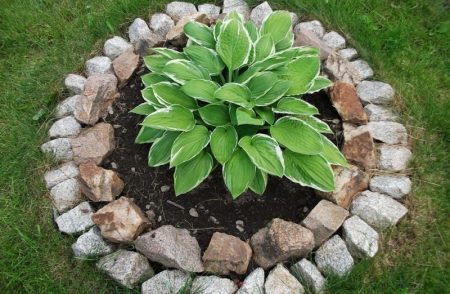
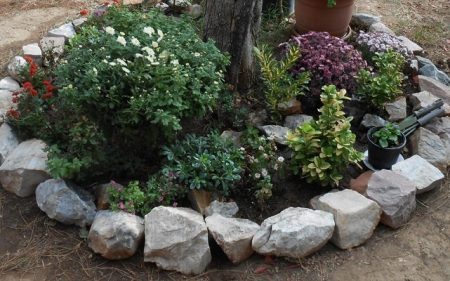
A standard flowerbed is easy to execute and maintain, since cement mortar is not meant here. It looks very natural and discreet, but this flowerbed, of course, will not give such an effect as a rock garden or rockery.
Stone selection
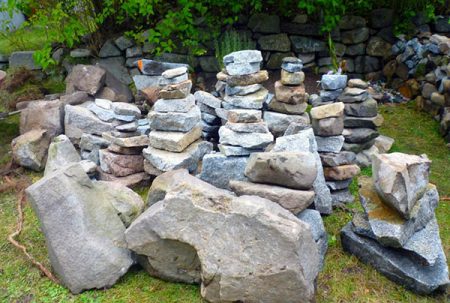
Stones for various compositions are selected based on the size of the flowerbed, design ideas, themes, planted plants, places in the garden, finally. If the shape of the structure is more than two square meters, then use large stones, and for small flower beds it is preferable to use small pebbles.
Natural
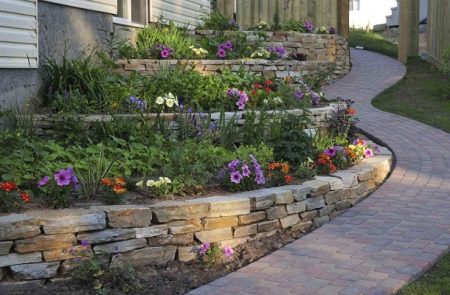
To create stone flower beds, decorators prefer to use real stone breeds. Old, time-tested and water-honed minerals, covered with mosses, natural cracks and flaws, make the composition more spectacular, exotic, exciting.
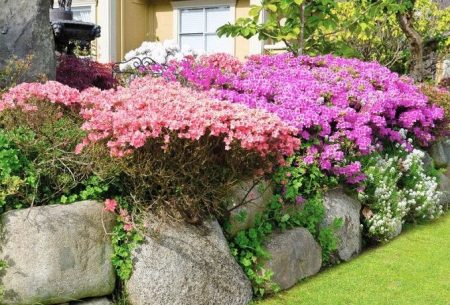
Advantages of natural materials:
- create a complete immersion in the wild;
- durable
- strong;
- a wide variety of natural specimens.
The most popular varieties in landscape design:
| Title | Characteristic |
| Quartz | Most often it is used to decorate flower beds. Mineral is a beautiful, multifaceted breed that has many shades, due to which you can create any kind of composition. Quartz tolerates temperature extremes, chemical effects.The effect is its strict relief: in the light, its sides shimmer in different shades, which makes the flowerbed playful. |
| Sandstone | Usually, partitions, hedges, stone wells are created from it, in the center of which perennial flowers are planted. Sandstone, due to its layered and porous structure, makes the composition of the flower garden more light and airy. For elevated compositions, huge boulders and rubble stones (subspecies of the breed) are suitable. However, the breed has a significant minus - fragility. After 2-3 years, the stone will begin to crumble, making the flower bed sloppy. |
| Slate | Slate is formed from clay. The breed looks like a multi-layered stone, which is easy to break into small thin plates. Durable, durable material, it is not afraid of cold weather, ultraviolet radiation, moisture resistant. Shale plates are used to a large extent for the design of raised beds and fences. Very high quality, but also expensive material. |
| Limestone | The material is most often painted in the colors of bed tones. A bed of limestone will always seem soft, non-aggressive. Over time, cracks form in the stones, into which dimensional flowers, mosses and ground cover plants can be planted. |
| Granite | Massive, solid, durable mineral, the owner of amazingly beautiful color. Granite makes any flowerbed pretentious, expensive and austere. The stone is famous for moisture and frost resistance. Minus of granite - it oxidizes the soil. |
| Basalt | The stone comes from magma. It can serve more than ten years without losing its graceful appearance. Sturdy, sturdy material, perfect for a floral border. |
| Volcanic tuff | Strong, but easily conducting air breed. It has delicate shades and rounded shapes. Usually climbing plants are planted on boulders from tuff, which beautifully braid it, making the composition as close as possible to the wild. |
| Pebbles | Pebbles are many stones that are different in color and size, but the same in shape - they should all be round. It is most often used for filling empty places in a flower bed, decorating borders and paths. A necessary attribute when creating a Japanese garden. Looks spectacular in gabions. For the design of small flower beds, pebbles are laid in a small layer on a cement substrate. |
Artificial
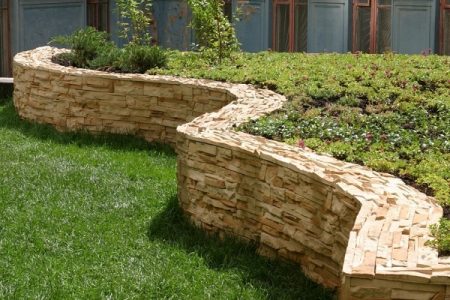
A brilliant alternative to natural breeds is artificially created materials, some of which sometimes can not be distinguished from real ones. Artificial stones are made from acrylic, crumbs of natural rocks, polyester oils. Decorated stone is an ideal solution for a summer resident, because it can imitate granite, slate and other rocks, which can be missed in the right amount.
Such natural materials decorate not only flower beds, but also the facades of houses, foundations, borders and fences. And all because they have good decorative qualities and are durable. However, using them, it should be borne in mind that many of them do not tolerate temperature extremes and prolonged contact with the ground, which causes deformation and shedding of stone. Artificial stones are most often used to raise the level of a flower garden, create a border of a flower bed and a flower fence.
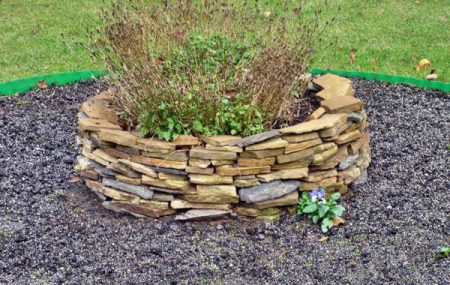
Pros of artificial stones:
- large selection of colors, shapes, sizes;
- lighter in weight than natural stones;
- availability;
- ability to imitate any structure;
- boundless design solutions.
Commonly used decorative materials:
| Title | Characteristic |
| Brick | Suitable for laying out a clearly symmetrical flower garden design. Usually a red look is used for these purposes. Suitable for small flower beds along the wall of the house. Brick is not used for laying the central flowerbed of the garden. |
| Slate | It happens in different colors. Suitable for "maintaining" flower beds along the path. Creates a fence view. |
| Polymer concrete | The breed is made of sand, cement and polymer oils. Durable, waterproof material. It tolerates frosts.Polymer concrete can be made of any design and size, so that with its help you can realize any imagination of the artist. |
Options for beds of stone
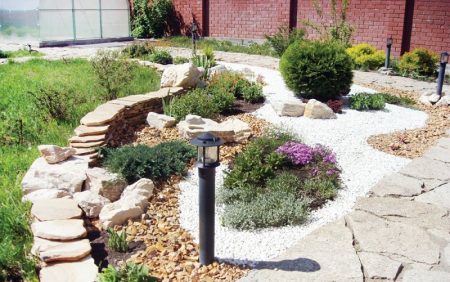
The idea of a flower bed can be one large stone. It is located in the center of the flower garden or with the edge, however it is he who sets the rhythm of the whole composition. Near him, flowers are planted. The drainage layer is made of gravel, gravel and sand.
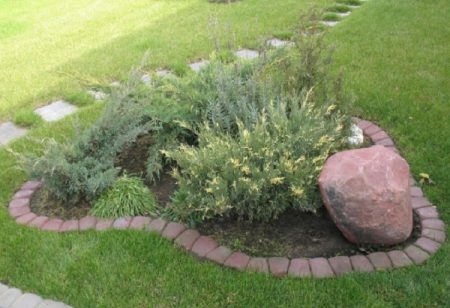
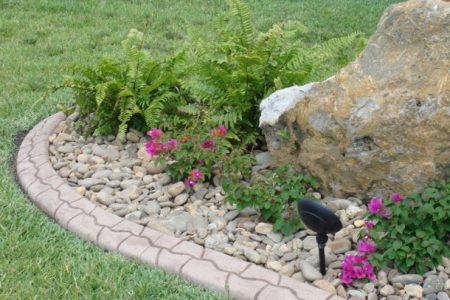
To create one flower bed, several types of rocks are selected, but all of them should be approximately the same characteristics. You can not mix all the stones in a row. It will look ridiculous.
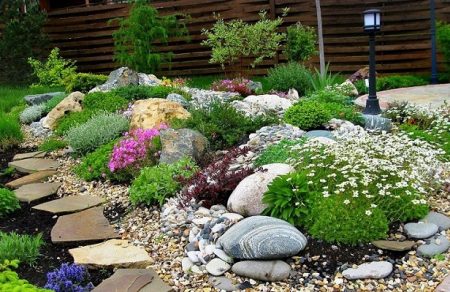
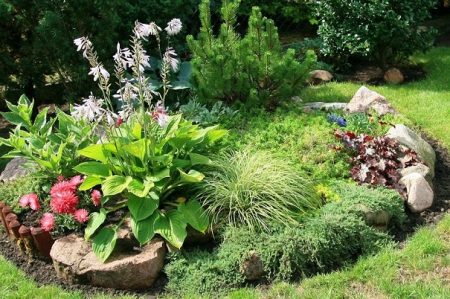
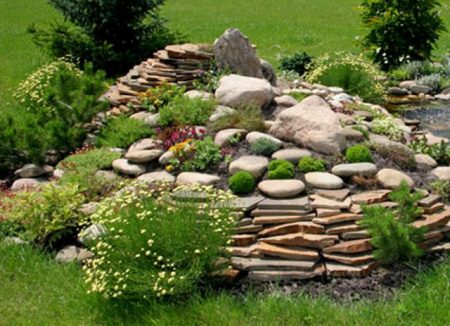
The curvature of the flowerbed lines is created by forming paths, ponds on its area, simulating waterfalls using jackdaws or marble chips.
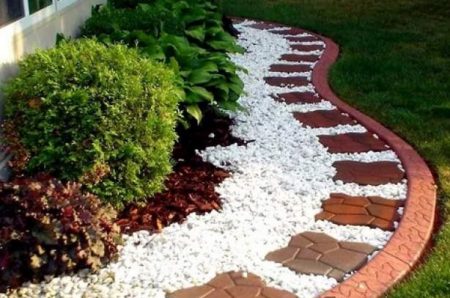
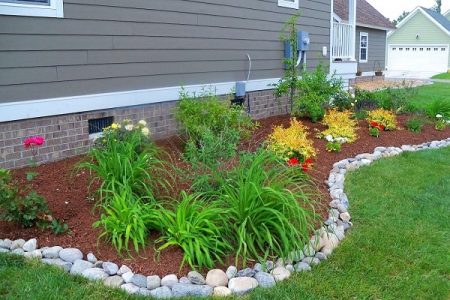
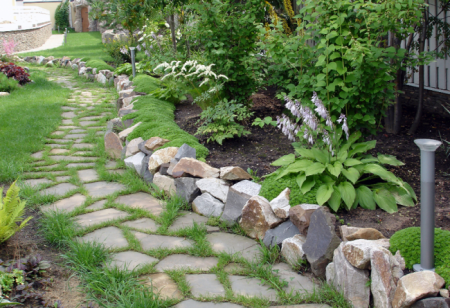
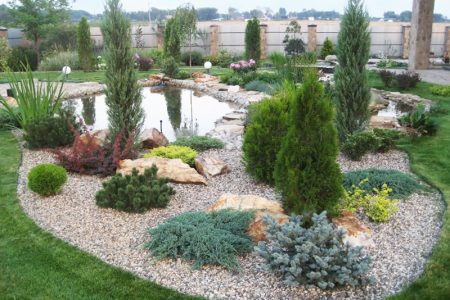
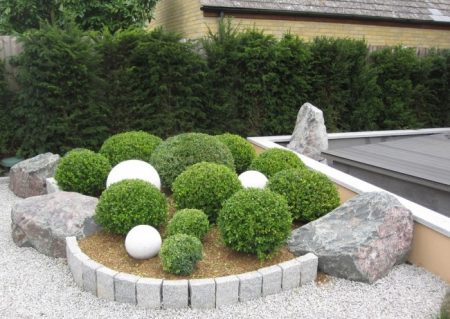
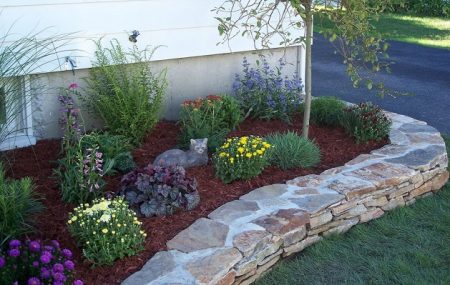
The flower bed, in which the rocks are added, must be multi-level, with a seasoned composition. On each "floor" there are certain flowers, which also must be combined in color, shape of inflorescences, flowering time.
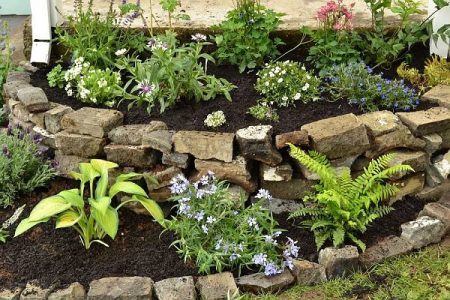
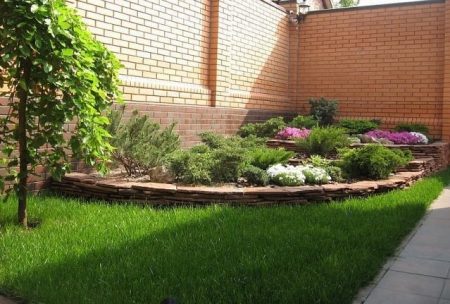
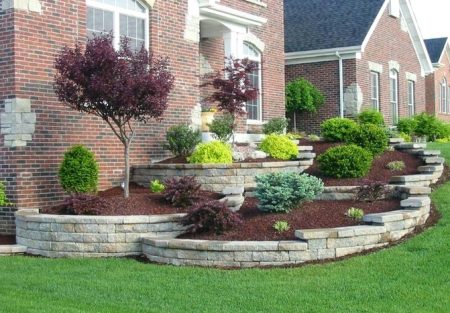
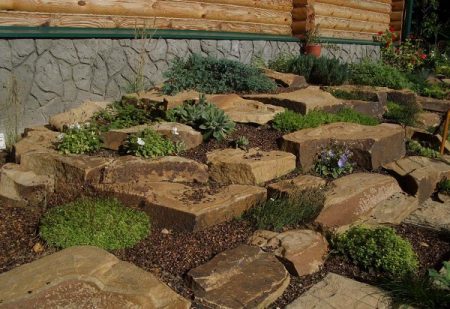
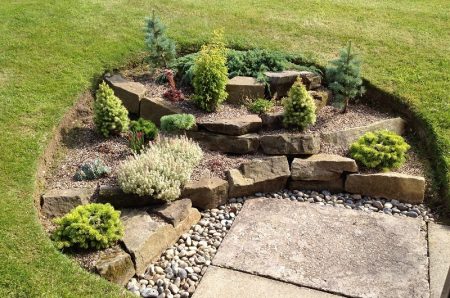
Features of the flower garden
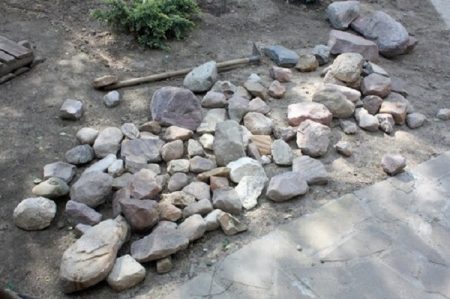
The front garden, in the design of which hard rocks are used, is a whole composition where each pebble lies in its place, and not, as many people think, a pile of cobblestones among which unknown flowers make their way. The construction of a rock garden or gabion requires careful preparation - terrain planning and selection of materials. The breakdown of the flower garden implies the transfer of the planned drawing from paper to the plot. Therefore, before starting excavation work, you should first draw a template for the future flowerbed, its size, location on paper.
Flowerbed placement
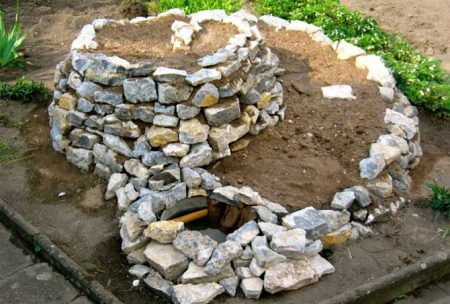
A flower bed made of stone is a work of decorative character. It should decorate the garden, and not create unnecessary problems, so its geographical location should be as comfortable as possible for the summer resident, and for the flowers growing in this flower garden. The ideal location of the flowerbed is a sunny, quiet place in the center of the garden, along the fence or under the windows of the house directly against the wall. The main thing is that the flower garden does not "get in the way", that is, it does not interfere with movement in the garden. In open areas, flowerbeds of smooth shape - round, oval or curly - look appropriate. In all other areas, you can create angular, rectangular compositions. You should also take into account the proportions - there should not be a lot of stones so that the imbalance of stone and plants does not work.
The principles of flower garden design:
- gabions are installed along blind fences, walls, fences;
- rock garden arrange on the lawn;
- in the center of the plot, an elevated flowerbed with a pond will look spectacular;
- on a flat surface, it is appropriate to place a rockery;
- on the slope of the garden it’s perfect to break the arabesque.
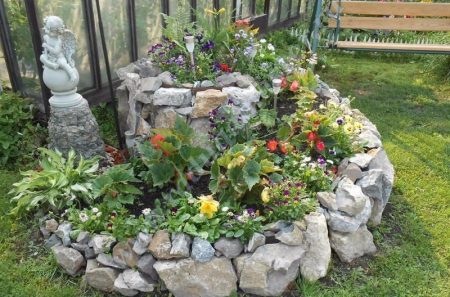
As the stones select the most compatible between the rocks, the plants should be the same in preference to light, soil, moisture, temperature. Incompatible in this regard, flowers will disharmonize and destroy the beauty of the flowerbed, as some of them may languish in the shade, and some may bloom poorly in the sun. It is also necessary to take into account the timing of flowering plants, their combination in color, shape and growth. If there is an irresistible desire to plant all the flowers of different varieties, colors and shapes at once, then it is better to do this in different flower beds. It will be more appropriate to divide the garden into several flower zones and arrange small flower beds that differ in the composition of the flora.
In the garden, one large flower bed looks better, but not many small ones.
Since the purpose of the flower garden is beauty and contemplation, one should carefully approach the selection of stony material here. So that the flower bed does not dazzle and does not look messy and comical, the color of the stone should be light or dark tones, if colorful plants are placed on the flower bed. Blue, green and other stones are best used for landscaping non-flowering plants.
Masonry technology
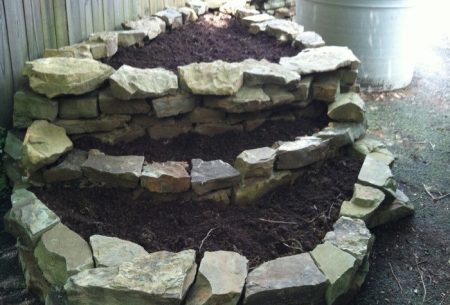
Only after the drawing is transferred to the ground, the contours are marked with wooden pegs and begin laying the flower garden.Heavy stones are dug into the ground, and pebbles are simply scattered along the outlined boundaries. If shale, limestone or sandstone is used in the flowerbed, then they are laid on top of each other, creating a layered structure of the composition.
Hard curbs are planted on cement so that the building does not deteriorate for decades. To do this, a small trench is dug around the perimeter of the flower garden pattern. Cement is poured into it, and stones of the required sizes and colors are laid on top, alternating layers with the solution. The solution is used from the inside, so that the outside gives the impression of accidentally laying a stone on top of each other. Such masonry usually has an attractive appearance especially along the fences and walls of the house. You can lay out a stone with a well, and pour earth into it and plant plants. Sealant is sprayed on the surface of the dried cement so as not to cause cracks.
Laying large disproportionate stones gives the composition an originality. Do not adjust them to size, it is better to give free rein to asymmetry, which will make the flowerbed unique. Arranging the "brick" masonry with stones, it is worth filling the voids with earth, carefully tamping these places.
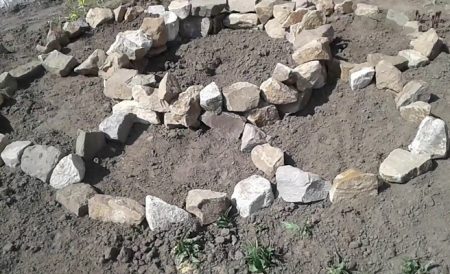
Plants are planted on both sides of the stone arches, with tall specimens in the center, and low specimens at the edges of the flower beds.
Conclusion
Adding a natural component - a stone - to the composition of the flower garden, the summer resident can have no doubt that the flower bed will sparkle with new colors. The stone element of the decor looks very catchy and makes a good impression. However, when creating landscaping in your garden, you need to understand that stone structures are demanding care. From pollution and moisture, stony rock must be treated with specialized compounds that can preserve the primordial stone for many years.

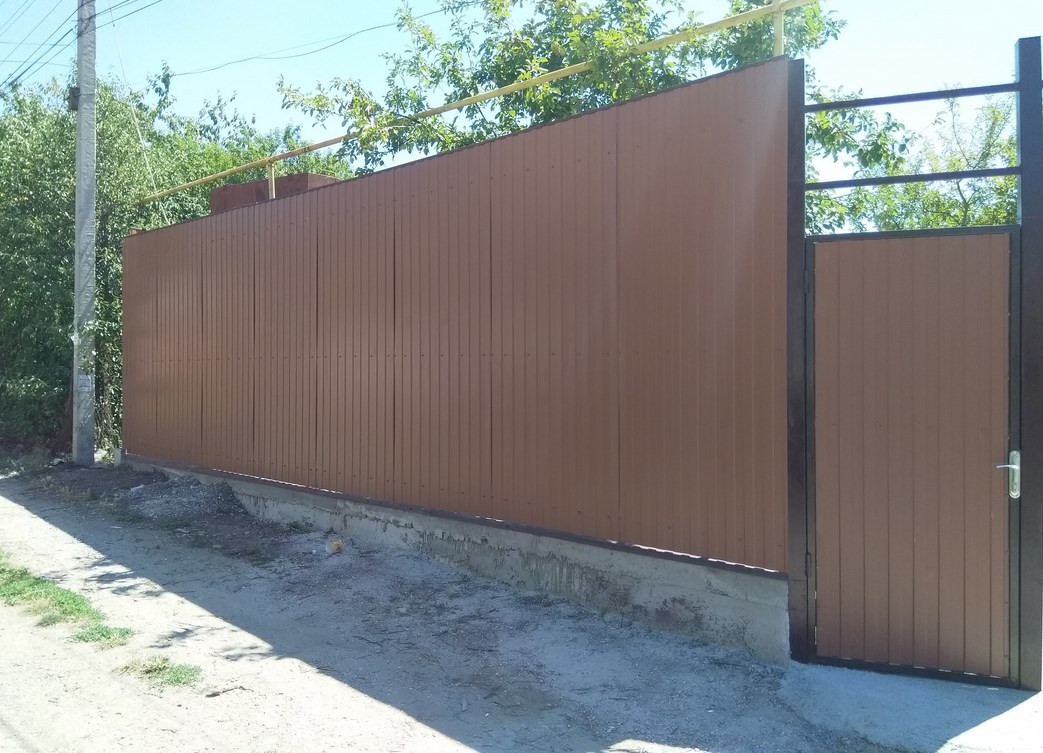
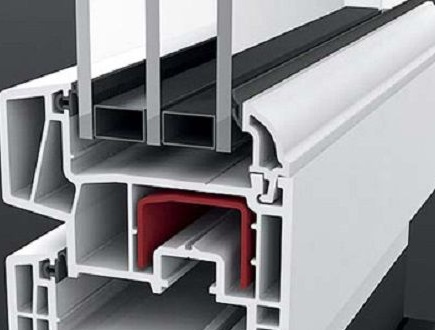
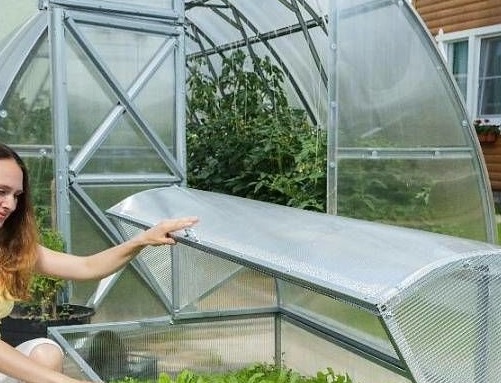
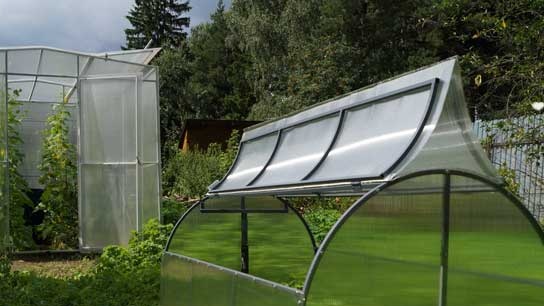 Why is a greenhouse open top?
Why is a greenhouse open top?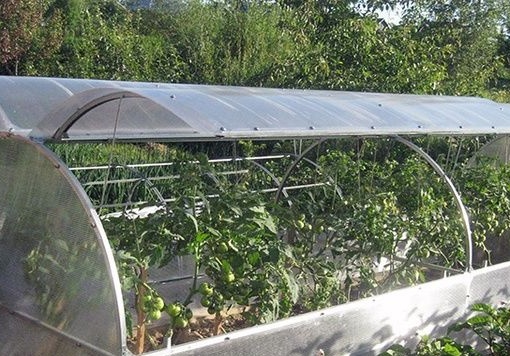 Greenhouse "Butterfly", is it worth it?
Greenhouse "Butterfly", is it worth it?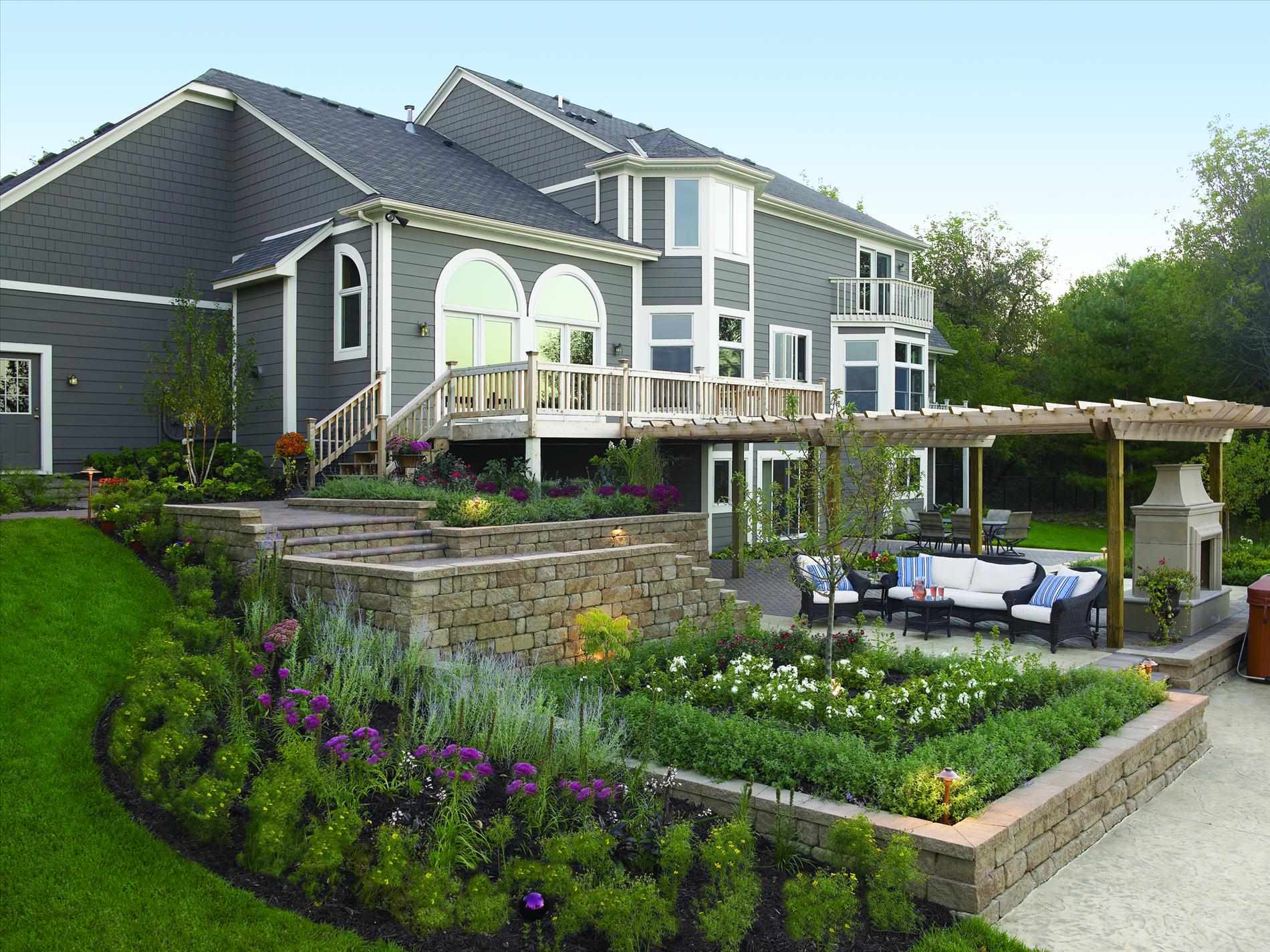 Do-it-yourself landscaping of an area of 8 acres: features of planning and zoning
Do-it-yourself landscaping of an area of 8 acres: features of planning and zoning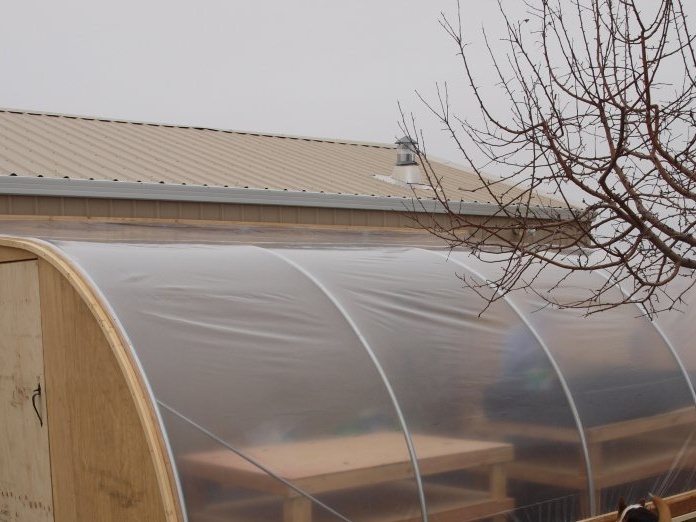 Shed greenhouse, pros and cons
Shed greenhouse, pros and cons